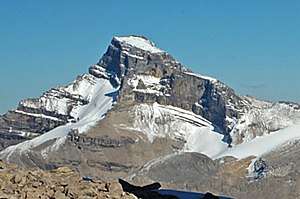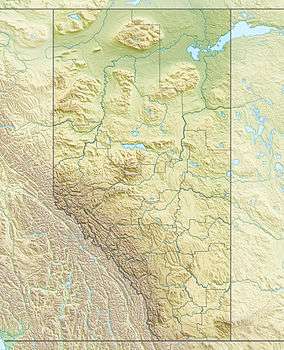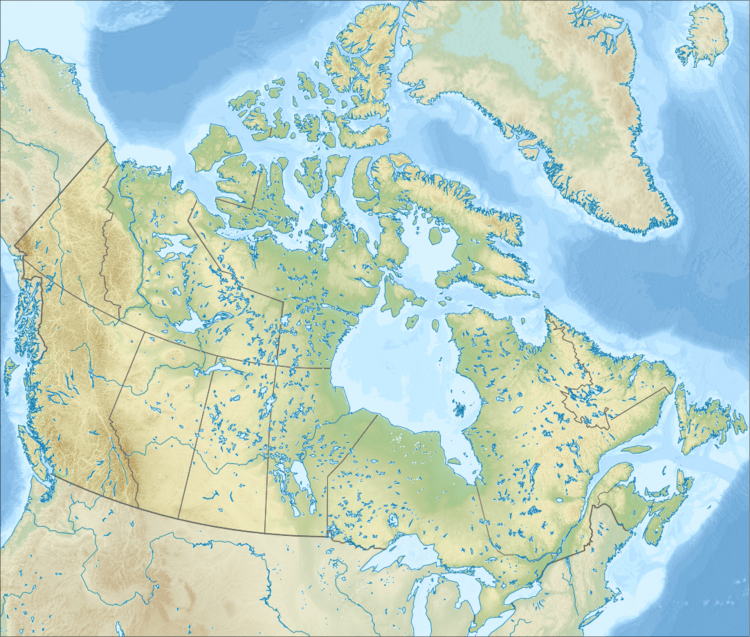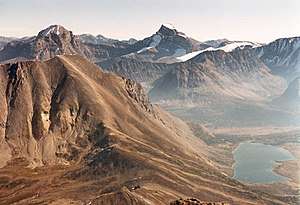Mount St. Bride
Mount St. Bride is a prominent 3,312-metre (10,866-foot) mountain summit located in Banff National Park, in the Canadian Rockies of Alberta, Canada. It is the highest point in the Sawback Range.[4] Its nearest higher peak is Cataract Peak, 18.8 km (11.7 mi) to the northwest.[1] The mountain is situated 2.0 km (1.2 mi) to the south of Mount Douglas near the headwaters of the Red Deer River.
| Mount St. Bride | |
|---|---|
 Mount St. Bride | |
| Highest point | |
| Elevation | 3,312 m (10,866 ft) [1] |
| Prominence | 1,207 m (3,960 ft) [1] |
| Parent peak | Mount Hector (3394 m)[1] |
| Listing | Mountains of Alberta |
| Coordinates | 51°30′28″N 115°57′19″W [2] |
| Geography | |
 Mount St. Bride Location of Mount St. Bride in Alberta  Mount St. Bride Mount St. Bride (Canada) | |
| Location | Alberta, Canada |
| Parent range | Sawback Range Canadian Rockies |
| Topo map | NTS 82O12 |
| Geology | |
| Age of rock | Cambrian |
| Type of rock | Sedimentary rock |
| Climbing | |
| First ascent | 1910 J.W.A. Hickson, Edward Feuz Sr., Edward Feuz Jr.[3] |
History
Mount St. Bride was named in 1898 for Saint Bride, the patron saint of the Douglas family.[3][5]
The first ascent of the mountain was made in 1910 by J. W. A. Hickson with guides Edward Feuz Sr. and Edward Feuz Jr.[3].
The mountain's name was officially adopted in 1956 when approved by the Geographical Names Board of Canada.[2]
Geology
Like other mountains in Banff Park, Mount St. Bride is composed of sedimentary rock laid down during the Precambrian to Jurassic periods.[6] Formed in shallow seas, this sedimentary rock was pushed east and over the top of younger rock during the Laramide orogeny.[7]

Climate
Based on the Köppen climate classification, Mount St. Bride is located in a subarctic climate zone with cold, snowy winters, and mild summers.[8] Temperatures can drop below −20 °C with wind chill factors below −30 °C.
References
- "Mount Saint Bride". Bivouac.com. Retrieved 2019-02-16.
- "Mount St. Bride". Geographical Names Data Base. Natural Resources Canada. Retrieved 2019-02-16.
- "Mount St. Bride". PeakFinder.com. Retrieved 2019-09-21.
- "Mount Saint Bride". Peakbagger.com. Retrieved 2019-09-21.
- Place-names of Alberta. Ottawa: Geographic Board of Canada. 1928. p. 112.
- Belyea, Helen R. (1960). The Story of the Mountains in Banff National Park (PDF). parkscanadahistory.com (Report). Ottawa: Geological Survey of Canada. Archived (PDF) from the original on 2015-10-02. Retrieved 2019-09-13.
- Gadd, Ben (2008). Geology of the Rocky Mountains and Columbias.
- Peel, M. C.; Finlayson, B. L. & McMahon, T. A. (2007). "Updated world map of the Köppen−Geiger climate classification". Hydrol. Earth Syst. Sci. 11: 1633–1644. ISSN 1027-5606.